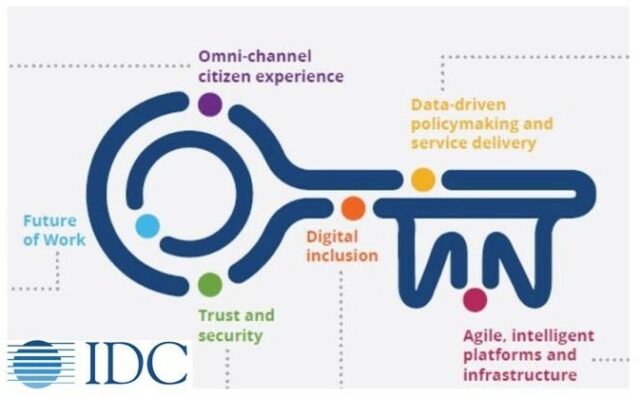With Covid-19 vaccination programs underway and fiscal relief and furlough measures winding down, the focus of international governments is gradually turning from short-term recovery to laying the foundations for sustainable long-term growth. Policymakers are now confronted with strategic choices on how to ensure a fair, equitable and connected society post-pandemic.
This is why, earlier this year, Dell Technologies partnered with the International Data Corporation (IDC), the premier global provider of market intelligence, on a series of info-briefings to help navigate these changes and provide support and recommendations on the keys to unlocking opportunities in the next normal.
In search of an ambitious, citizen-focused recovery and green transition, governments have rightly identified digital transformation as a key driver. Digital is at the heart of national recovery packages across the Americas, Asia and Europe. According to IDC, Germany alone will invest 40% of its €50billion package in accelerating digitalization in various sectors, with most of the stimulus going to broadband expansion, online public services and digitalizing the national economy.
Smart investments in the digital transformation of the public sector have enormous potential to improve social well-being by driving long-term economic growth, accelerating global sustainability efforts and addressing long-term systemic challenges.
In addressing the challenges brought about by the pandemic, a stark lesson for public organizations has been that significant technological changes were needed to succeed in the next normal. Overall, under 10% of public authorities said they had not faced any organizational challenges as a result of Covid-19 and the emergence of new working models.
The keys to successful digital transformation
IDC’s research shows that core to the successful digital transformation of public services are six keys:
- Establishing an omnichannel citizen experience
- Ensuring trust and security
- Promoting data-driven policymaking and service delivery
- Adapting to the future of work
- Enabling digital inclusion
- Building agile, intelligent platforms and infrastructure
The first three keys are critical enablers in accelerating digital transformation across all aspects of public services.

Omni-channel communications via portals that consolidate government data enable users to access more information and services. The use of APIs, machine learning, and intelligent process automation can make the delivery of public services far more efficient, responsive and economical. For example, they can shorten the process for the notification and payment of taxes or license fees as well as for access to government payments like unemployment benefits.
A pertinent example of the potential of omnichannel communications comes from the city of Vienna, which built on its citizen-centric approach by repurposing some of its more advanced communication channels to deliver Covid-19 relevant information and help maintain compliance with guidance. Using a chatbot (WienBot) to deliver information on new measures, local authorities alleviated pressure on the main information line, preserving a crucial resource for citizens.
Another key building block is security and trust. Digitalization provides citizens with ease of access to public services, but trust in the security of IT solutions is needed for their uptake. This is well recognized today, with just under half of all government agencies identifying digital trust programs as a top business priority heading beyond 2021.
Robust cybersecurity strategies are essential. An early leader in this area is Australia, through its ‘Cyber Security Strategy 2020’, comprising an investment of A$1.67 billion over 10 years, that will target improving the competitiveness of its industry through AustCyber, the Australian Cyber Security Growth Network. By bringing together start-ups, venture capital funds, government agencies and educational institutions, AustCyber will act as a multiplier and connector for the Australian cybersecurity industry.
Public authorities providing secure access to government services must also not discourage users by making things too complex. Digital identity solutions can help address the challenge of balancing security with convenience. France significantly improved its services by enabling France Connect, a log-in mechanism recognized by all public services. At the EU level, just last month the European Commission proposed new legislation introducing an EU-wide voluntary digital identity wallet scheme to enable access to public services securely.
Finally, data should be leveraged as a strategic asset. Governments may invest in innovative solutions such as Big Data, analytics, and machine learning but too often organizational obstacles, legal and political boundaries and insufficient internal know-how mean data is not converted into actionable insights.
The potential of effective data-driven approaches is well illustrated by the STOIC project, started in the Cochin hospital in Paris. In medical care, there is a need for increased data sharing and collaboration to quickly obtain data sets large enough for treatment design. With access to new databases and pilot solutions using AI for lung imaging through STOIC, physicians were able to leverage data to optimize patient treatment plans.
The key to unlocking this potential is reforming data regulation to facilitate access and sharing of data. Through initiatives like the EU’s drive to create data spaces like the European Health Data Space and facilitate business-to-government data sharing through its Data Act, public authorities in the EU will be better able to realize the true value of data.
Building momentum
The digital transformation of public services has the potential to significantly improve societal well-being through more efficient, secure, responsive and human-centric services as well as being a driver for economic growth.
Governments across the world have recognized its importance in their recovery plans. However, while the objectives of these plans are long-term, the window to secure funding is closing. In France, for instance, the strategy has an end date of 2030 but most plans will be executed and funded between 2021–2022.
Public authorities, therefore, face a pivotal moment. To capitalize on the available funding and technological solutions, governments will need to embrace ambitious reform programs for public services, addressing all six building blocks of digital transformation.
